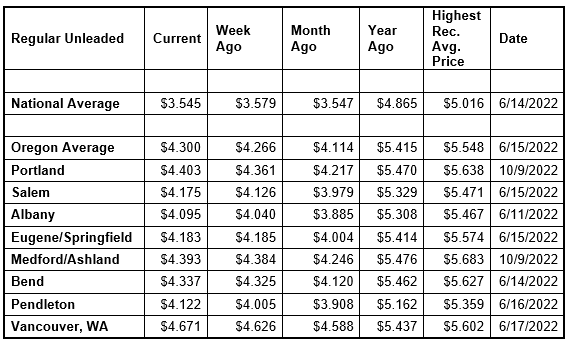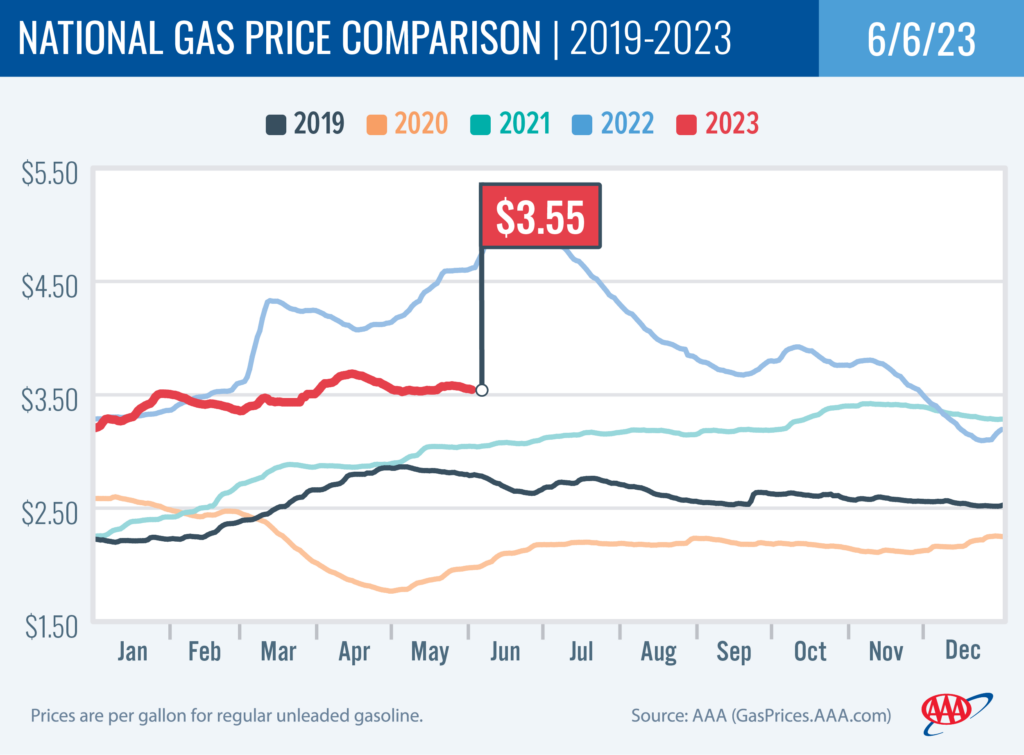PORTLAND, Ore., – Gas prices are showing minimal movement this week. Most states including Oregon are seeing prices change by a few cents or less. Relatively low crude oil prices and a dip in demand for gas in the U.S. are helping to keep pump prices fairly steady. For the week, the national average for regular slips three cents to $3.55 a gallon. The Oregon average gains three cents to $4.30.

Crude oil prices remain below $75 per barrel, despite news from Saudi Arabia over the weekend that it would cut production by about a million barrels a day in July, dropping from 10 million to nine million barrels a day. At its June 4 meeting, the Organization of the Petroleum Exporting Countries and other major oil producers, including Russia, known collectively as OPEC+, also said that it would extend production cuts of more than 1 million b/d through 2024. OPEC+ first announced the production cuts at its April meeting and said the cuts would be in effect through 2023. OPEC+ pumps about 40% of the world’s crude oil.
“A downtick in demand for gas and crude prices remaining in the low $70s per barrel should help put downward pressure on pump prices, barring unexpected disruptions in supply,” says Marie Dodds, public affairs director for AAA Oregon/Idaho. “Factors that have the potential to send pump prices climbing again include refinery or pipeline disruptions, hurricanes, and economic or geo-political events that impact global markets.”
Crude oil is trading around $72 today compared to $69 a week ago and $119 a year ago. In May, West Texas Intermediate ranged between about $63 and $77 per barrel. In April, WTI ranged between about $73 and $83. In March, WTI ranged between about $64 and $81 per barrel. In February, WTI ranged between about $73 and $80 per barrel. In January, WTI ranged between about $73 and $82 bbl. Crude reached recent highs of $123.70 on March 8, 2022, shortly after the Russian invasion of Ukraine, and $122.11 per barrel on June 8, 2022. The all-time high for WTI crude oil is $147.27 in July 2008.
Crude oil is the main ingredient in gasoline and diesel, so pump prices are impacted by crude prices on the global markets. On average, about 56% of what we pay for in a gallon of gasoline is for the price of crude oil, 20% is refining, 11% distribution and marketing, and 14% are taxes, according to the U.S. Energy Information Administration.
Demand for gasoline in the U.S. demand decreased from 9.43 to 9.1 million b/d for the week ending May 26. Lower demand has helped to cap increases in pump prices. This compares to 8.98 million b/d a year ago.
Meanwhile, total domestic gasoline stocks dropped slightly to 216.1 million bbl. If gas demand declines, drivers will likely see pump prices fall.
Quick stats
Oregon is one of 15 states and the District of Columbia with higher prices now than a week ago, and 47 states and D.C. saw prices change by a dime or less in the last week. Indiana (-12 cents) has the largest weekly decrease. Idaho (+9 cents) has the largest weekly gain.
California ($4.86) has the most expensive gas in the nation for the 14th week in a row. Hawaii ($4.75) is second, Washington ($4.72) is third, Arizona ($4.40) is fourth, Oregon ($4.30) is fifth, Nevada ($4.26) is sixth, and Utah ($4.13) is seventh. These are the seven states with averages at or above $4 a gallon. This week 42 states and the District of Columbia have averages in the $3-range. One state, Mississippi ($2.96) has an average in the $2 range this week, same as a week ago.
The cheapest gas in the nation is in Mississippi ($2.96) and Texas ($3.08). For the 125th week in a row, no state has an average below $2 a gallon.
The difference between the most expensive and least expensive states is $1.90 this week, compared to $1.87 a week ago.
Oregon is one of 29 states with higher prices now than a month ago. The national average is the same and the Oregon average is 19 cents more than a month ago. Arizona (-23 cents) has the largest monthly drop. Utah (+20 cents) has the largest month-over-month increase.
All 50 states and the District of Columbia have lower prices now than a year ago. The national average is $1.32 less and the Oregon average is $1.12 less than a year ago. Indiana (-$1.54) has the largest yearly drop. Washington (-69 cents) has the smallest. A year ago, pump prices were rising rapidly after the Russian invasion of Ukraine.
West Coast
The West Coast region continues to have the most expensive pump prices in the nation with all seven states in the top 10. It’s typical for the West Coast to have six or seven states in the top 10 as this region tends to consistently have fairly tight supplies, consuming about as much gasoline as is produced. In addition, this region is located relatively far from parts of the country where oil drilling, production and refining occurs, so transportation costs are higher. And environmental programs in this region add to the cost of production, storage and distribution.
| Rank | Region | Price on 6/6/23 |
| 1 | California | $4.86 |
| 2 | Hawaii | $4.75 |
| 3 | Washington | $4.72 |
| 4 | Arizona | $4.40 |
| 5 | Oregon | $4.30 |
| 6 | Nevada | $4.26 |
| 7 | Utah | $4.13 |
| 8 | Alaska | $3.96 |
| 9 | Idaho | $3.92 |
| 10 | Illinois | $3.87 |
As mentioned above, California has the most expensive gas in the nation for the 14th week in a row. Hawaii Washington, Arizona, Oregon, and Nevada round out the top six. Alaska is eighth. Oregon rises to fifth after six weeks at sixth.
States in the West Coast region are seeing small to moderate changes on the week: Arizona (-12 cents), Oregon (+3 cents), Washington (+3 cents), Nevada (-2 cents), Alaska (+1 cent), Hawaii (+1 cent), and California (-3/10th of a cent).
The refinery utilization rate on the West Coast rose from 86.9% to 90.7% for the week ending May 26. This rate has ranged between about 73% to 92% in the last year. The latest national refinery utilization rate is 93.1%.
According to EIA’s latest weekly report, total gas stocks in the region increased from 27.79 million bbl.to 28.33 million bbl.
A higher refinery utilization rate and an increase in gasoline stocks can put downward pressure on pump prices.
Oil market dynamics
Crude oil prices rose to start this week after Saudi Arabia said it would make more production cuts starting in July. The announcement came at the June 4 meeting of OPEC+. The price of WTI fell to $68.04 last Wednesday, then remained above $70 for the rest of the week. The EIA reported that total domestic commercial crude inventories increased significantly by 4.5 million bbl to 459.7 million bbl last week.
At the close of Friday’s formal trading session, WTI gained $1.64 to settle at $71.74. At the close of Monday’s formal trading session, WTI added 41 cents to close at $72.15. Today crude is trading around $72, compared to $69 a week ago. Crude prices are about $47 less than a year ago.
Drivers can find current gas prices along their route with the free AAA Mobile app for iPhone, iPad and Android. The app can also be used to map a route, find discounts, book a hotel and access AAA roadside assistance. Learn more at AAA.com/mobile.

Diesel
For the week, the national average loses three cents to $3.92 a gallon. The record high is $5.816 set on June 19, 2022. The Oregon average dips a penny to $4.43. The record high is $6.47 set on July 3, 2022. A year ago the national average for diesel was $5.65 and the Oregon average was $5.98.
Find current fuel prices at GasPrices.AAA.com.
AAA news releases, high resolution images, broadcast-quality video, fact sheets and podcasts are available on the AAA NewsRoom at NewsRoom.AAA.com.
Find local news releases at https://oregon.aaa.com/community/media/media-contacts.html
Fuel prices are updated daily at AAA’s Daily Fuel Gauge at AAA Gas Prices. For more info go www.AAA.com. AAA Oregon/Idaho provides more than 880,000 members with travel, insurance, financial and automotive-related services, and is an affiliate of AAA National, serving more than 63 million motorists in North America.

